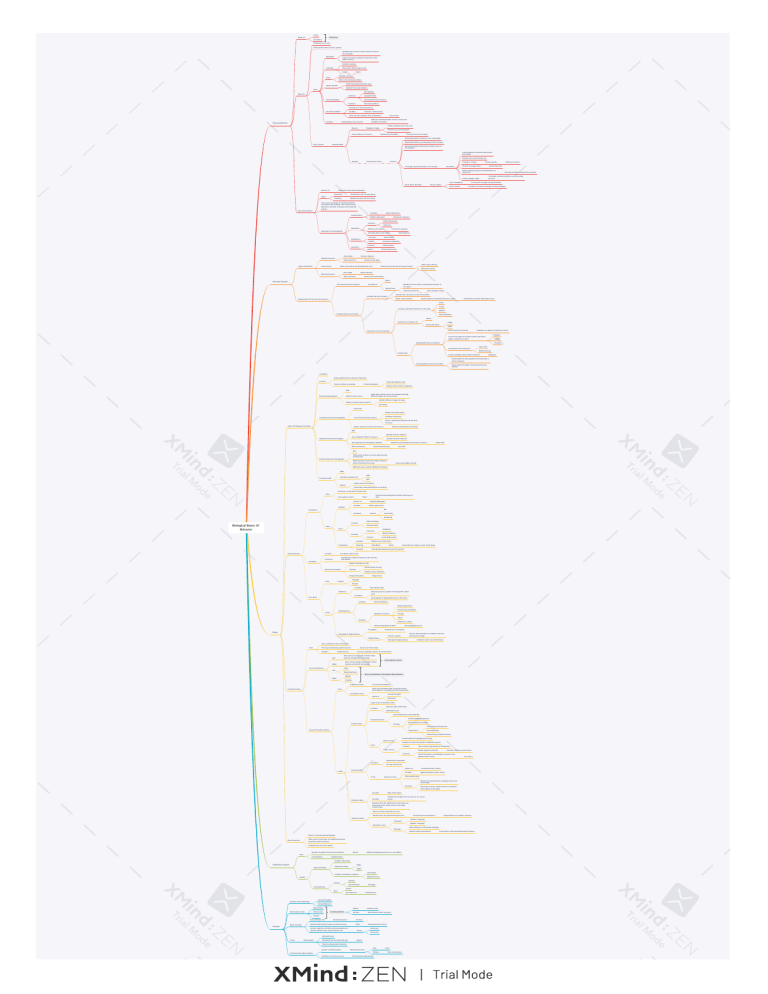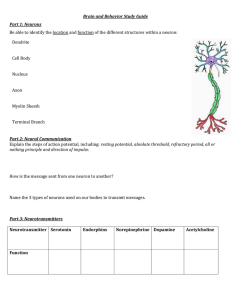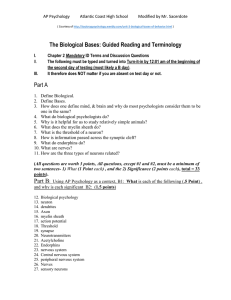
Parts Study of Of Neuron Functions Individual nerve cells make up the entire nervous system Rootlike parts of the cell that stretch out from the cell body Dendrites It grows to make synaptic connections with other neurons Contains nucleus Cell Body other parts that sustain its life Called Soma Wirelike structure Axon Ends in the terminal buttons Fatty Covering around the axon Myelin Sheath Speeds the neural impulse Parts End buttons Neurons Called as Synaptic Knob Contains Neurotransmitters Terminal Buttons Terminal Branches Of Axon Chemicals in terminal buttons Neurotransmitters Enables Neurons communicate It fits into the receptor sites of dendrites Synapse Neuroautonomy Key to lock Between terminal button of one neuron and dendrite of another Gap between two neurons Neuron Mostly negative ions in the cell Negative charge Cell membrane of neuron Positive ions surrounding it Selectively permeable Prevents ions from mixing Terminal buttons of Neuron A are stimulated Neurotransmitters are released into the synapse How It Fires? Resting State Neurotransmitters fit into the receptor sites of the dendrite Cell membrane of Neuron B becomes permeable Positive ions rush into the cell Imagine Two Neuron Chain Process Change in charge If enough neurotransmitters are received Threshold Travels quickly Electric message firing Process begins again All Or None Principle What is it? Fires completely Neuron either 120m per second Action Potential When charge reaches terminal buttons of Neuron B Neurotransmitter released into synapse If enough neurotransmitters are received by next cell If it receives enough neurotransmitter Does not fire If it does not receive enough neurotransmitters Chemicals in the terminal buttons Excitatory Types Excited the next cell into firing Inhbitory Inhibits the next cell from firing The amount and type of neurotransmitters received on the receptor sites of the neuron determine whether it will pass the threshold and fire Neurotransmitters Function Acetylcholine Motor Movement Deficit will lead to Function Involved in addictions Mood Control Deficit Also called Afferent Neurons Schizophrenia Pain Control Deficit Function Serotonin Clinical Depression Sensory Neuron Takes info from Senses to the brain Once info reaches the brain/spinaal cord Also called Efferent Neurons Parkinson's disease Overabundance will lead to Endorphins Interneurons Alertness Deficity will lead to Important to Psychologists Types Of Neurons Alzheimer's Disease Motor Movement Function Dopamine Other parts of brain Interneuron sends the message to either Efferent neurons Motor Neurons Takes info from brain to rest of the body Brain Nervous System The Central Nervous System Bundle of nerves that run through the center of the spine Consists of Spinal Cord Transmits info from Rest of body to brain Controls the voluntary muscle movements Somatic Nervous System Motor cortex of brain Organization Of The Nervous System Sends impulses to Somatic Nervous sytem Controls the muscles allowing to move Heart Lungs Controls automatic functions of the body Glands Peripheral Nervous System Internal Organs Stress Controls our response to Flight Perceived threat Fight Alert system of the body Autonomic Nervous System Mobilizes our body to respond to stress Organs Carries messages to control system that direct body's response to stress Glands Sympathetic Nervous System Muscles Accelerates some functions Divided into Heart rate Blood pressure Conserves/Slows down other functions Digestion Responsible for slowing down the body after a stress response Parasympathetic Nervous System Slows down the body's Autonomic Nervous System Accidents Removal/Destruction of part of the brain Lesions Famous historical example Make the patients calm Frontal Lobotomy Relieve some serious symptoms EEG Electroencephalogram What type of brain waves are produced during different stages of consciousness Detects brain waves Identify different stages of sleep Widely used for sleep research Dreaming CAT Scan Rotate around the brain Computerized Axal Tomography Combine all pictures Uses Several X Ray cameras Forms a detailed 3 D Picture of the brain structure Ways Of Studying The Brain Shows only the structure of the brain Not the function/activity of brain MRI Density of brain material Uses magnetic fields to measure Magnetic Resonance Imaging Location of brain material Not exposed to Carcinogenic radiation Shows Structure Substance promoting the formation of cancer Not function/activity Unlike CAT Like CAT PET What areas of brain are most active during certain tasks Positron Emission Tomography Measures how much of a certain chemical, parts of the brain are using more used, higher activity Different scans used for different chemicals fMRI MRI Combines elements of Functional MRI PET Details of brain structure Shows Information about blood flow in the brain Structures in top part of spinal cord Intro Life support system Controls basic biological functions that keep us alive Why? Known as Medulla Oblangata Location Medulla Above spinal cord BP Hind Brain Functions Control Heart Rate Breathing Above Medulla Location Biological Bases Of Behavior Towards front Parts Pons Connects Function Controls Cerebellum Location Brain Structure Mid & Forebrain Facial Expressions Location Bottom rear of the brain Meaning Little Brain Function Coordinates habitual muscle movements Why? Looks like the smaller version of the brain Just above spinal cord Coordinates simple movements with sensory information Functions Mid Brain Hindbrain Netlike collection of cells Reticular forrmation General body arousal Controls Ability to focus attention If doesn't function Intro Deep Coma Thought Control Reason Location Top of brain stem Receiving sensory signals coming up the spinal cord Thalamus Functions Fore Brain Send signals to appropriate areas in the brain Location Next to thalamus Body temperature Sexual arousal (Libido) Hypothalamus Parts Metabolic Function Hunger Thirst Function Endocrine system Controls biological rhythms Amygdala Brain Morning/Night person Experiences of emotions Amygdala & Hippocampus Sent to other locations in cerebral cortex for permanent storage Memory system Hippocampus Damage to hippocampus Unable to retain new information Grey wrinkled surface of the brain Intro Thin layer of densely packed neurons Wrinkles Covers rest of the brain Called fissures Gets sensory image and controls motor function of right half of the body Left Logic Left Sequential tasks Brain Lateralization/ Hemisphere Specialisation Spatial Right Creative 8 different Lobes Cerebral Cortex Contralateral Control Gets sensory image and controls motor function of left half of the body Right Two Hemispheres Increase available surface area of the brain 4 on each hemisphere Area not associated with receiving sensory information or controlling muscle movements Intro Association Area Human thought Active in Behaviour Large areas of cerebral cortex Top front part of the brain Location Behind the eyes Anterior/front part of frontal lobe Directing thought process Prefrontal Cortex Frontal Lobes Brain's central executive Function Foreseeing consequences Areas Of Cerebral Cortex Important in Pursuing Goals Maintaining emotional control Responsible for language processing Broca's Area Inability to make movements needed for speech Parts Location Thin vertical strip at back of frontal lobe Motor Cortex Sends signals to muscles Function Known as Somato Sensory Cortex Location Parts Vice Versa On top of the brain Parietal Lobes Lobes Controls voluntary movements Top of the body is controlled by neurons in the bottom of the cortex Behind the frontal lobe Location Sensory Cortex Right behind the motor cortex Thin vertical strip Receives incoming touch sensations from rest of our body Function Occipital Lobes Top of the sensory cortex receives sensations from bottom of the body Location Back of the brain Function Interpret messages from our eyes in our visual cortex Impulses from the right half of each retina are processed in the visual cortex in the right occipital lobe Process sound sensed by our ears Sound waves are processed by the ears Temporal Lobes Interprets Wernicke's area Damage Brain is somewhat plastic/flexible Other parts of the brain can adapt themselves to perform other functions Brain Plasticity Younger brain are more plastic System of glands that secrete hormones Intro Controlled by Affects Different biological processes in our bodies Hypothalamus Produce adrenaline Endocrine System Fight Signals the body Adrenal Glands Flight Controls involuntary response Glands Men Heart Rate Blood Pressure Ovaries Woman Ovaries/testes Sex Hormone Estrogen Testes Sex Hormone Testosterone Human thoughts Another factor affecting Human Behavior Body shape Most human traits Introversion Nature Combined effect Nurture Genetic Code Environment where we grow Temper Every Human Cell Genetic Basic Concept 46 Chromosomes Genetic Material that makes up chromosomes Certain segments of DNA control production of specific proteins that control human trait 23 Pairs DNA Genes Deoxyribonucleic Acid Dominant Recessive identical twins Twins Monozygotic Develop from one fertilised egg Zygote Shares same genetic materials Gender is determined by Chromosomal Abnormalities Combine in an unusual way 23rd chromosome Men Female Chromosomal abnormality X&Y Two chromosome Turned into neural impulses Interpreted in our auditory cortices Written Language Spoken Language Affect ability to understand language Speech might sound fluent Lack Proper syntax & Grammatical structure







